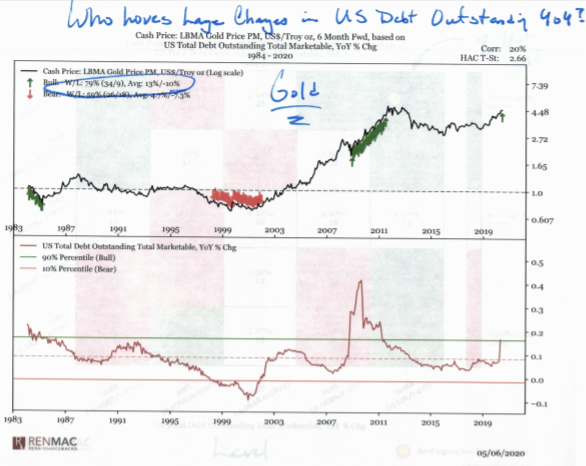The U.S. government is going on a borrowing binge, with the fiscal deficit set to hit $4 trillion this year in the wake of the COVID-19 pandemic. If history is a guide, that should be a positive for gold, a closely followed Wall Street chart watcher noted Thursday.
“What thrives in massive upside changes to Treasury debt outstanding? Gold of course,” wrote Jeff deGraaf, founder of Renaissance Macro, in a note featuring the chart below:

DeGraaf said a rise in outstanding debt issuance year-over-year tracks very closely to forward returns for gold. The chart shows the average six-month forward return for gold when year-over-year growth in debt issuance hits the 90th percentile is 13%, with the yellow metal rising 79% of the time, or in 39 out of 43 instances, going back to 1984.
“It’s about pace and level, and last time we saw something similar was during the aftermath of 2009 which gave us two solid years of gold performance before the contraction of 2010 portended correctly the cyclical peak,” he wrote.
June gold GC00, +1.55% was up $11.30, or 0.7%, at $1,699.80 an ounce, erasing a weekly loss even as stocks and the U.S. dollar gained ground.
The Dow Jones Industrial Average DJIA, +1.65% was up around 320 points, or 1.4%, while the S&P 500 SPX, +1.71% also advanced around 1.4%.
Gold can see its haven appeal diminished as stocks rise, while a stronger U.S. dollar makes commodities priced in the currency more expensive to users of other currencies.
But some analysts have argued that gold should find support even if stocks continue to push higher in a rebound from their March 23 lows as investors look for a hedge against any downside shocks in coming weeks or months as the damage from the pandemic becomes clear.
The U.S. Treasury Department earlier this week said it planned to borrow nearly $3 trillion this quarter as it moves to fund emergency programs approved by Congress to cushion the economy from the blow caused by the pandemic. That’s five times as large as the previous quarterly record set amid the 2008 financial crisis.
The deficit is on track to hit a nominal record of $3.7 trillion in fiscal 2020, according to the Congressional Budget Office, well above the previous record of $1.413 trillion seen in 2009, while the national debt is poised to soon top $25 trillion.
Much of gold’s underperformance in the 1990s came as the amount of debt outstanding grew at a relatively slow rate, predictably bottoming when debt growth rates turned negative briefly at the beginning of the 21st century as the government budget temporarily moved into surplus, deGraaf said.
“This data, and the trend, continue to support our call on gold as an asset class,” he wrote.





